Devices with feeling: new tech creates buttons and shapes in mid-air

9 photos: Feeling without touching
Microsoft's
Kinect for Xbox has long offered motion sensing input for gaming and
multimedia controls, but it lacks the haptics factor.
Hide Caption
5 of 9
9 photos: Feeling without touching
Oculus VR, bought by Facebook in 2014 for $2 billion, is at the forefront of virtual reality technology.
Hide Caption
6 of 9

9 photos: Feeling without touching
The Oculus visor is still under development, and said to be "many months, but not years," from release.
Hide Caption
7 of 9

9 photos: Feeling without touching
Magic Leap, founded in 2014, had demoed impressive augmented reality technology applied to gaming.
Hide Caption
8 of 9
9 photos: Feeling without touching
Valve, one of the most respected videogame developers, has entered the VR arena with a visor under development by HTC.
Hide Caption
9 of 9
9 photos: Feeling without touching
UltraHaptics technology creates 3D shapes in mid-air using focused ultrasonic waves.
Hide Caption
1 of 9

9 photos: Feeling without touching
Potential application include computers, home appliances, and cars.
Hide Caption
2 of 9

9 photos: Feeling without touching
Virtual reality gaming would greatly benefit from the addition of tactile feedback.
Hide Caption
3 of 9
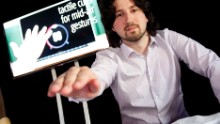
9 photos: Feeling without touching
Unlike other systems which just recognize hand gesture, haptics provide actual feedback on the user's skin.
Hide Caption
4 of 9

9 photos: Feeling without touching
Microsoft's
Kinect for Xbox has long offered motion sensing input for gaming and
multimedia controls, but it lacks the haptics factor.
Hide Caption
5 of 9

9 photos: Feeling without touching
Oculus VR, bought by Facebook in 2014 for $2 billion, is at the forefront of virtual reality technology.
Hide Caption
6 of 9

9 photos: Feeling without touching
The Oculus visor is still under development, and said to be "many months, but not years," from release.
Hide Caption
7 of 9

9 photos: Feeling without touching
Magic Leap, founded in 2014, had demoed impressive augmented reality technology applied to gaming.
Hide Caption
8 of 9

9 photos: Feeling without touching
Valve, one of the most respected videogame developers, has entered the VR arena with a visor under development by HTC.
Hide Caption
9 of 9

9 photos: Feeling without touching
UltraHaptics technology creates 3D shapes in mid-air using focused ultrasonic waves.
Hide Caption
1 of 9

9 photos: Feeling without touching
Potential application include computers, home appliances, and cars.
Hide Caption
2 of 9

9 photos: Feeling without touching
Virtual reality gaming would greatly benefit from the addition of tactile feedback.
Hide Caption
3 of 9

9 photos: Feeling without touching
Unlike other systems which just recognize hand gesture, haptics provide actual feedback on the user's skin.
Hide Caption
4 of 9

9 photos: Feeling without touching
Microsoft's
Kinect for Xbox has long offered motion sensing input for gaming and
multimedia controls, but it lacks the haptics factor.
Hide Caption
5 of 9

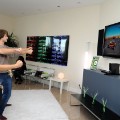




Story highlights
- A company called UltraHaptics has developed a technology to create 3D shapes in mid-air
- A tactile sensation is provided by ultrasonic waves, which alter air pressure
- The technology could be applied to electronic devices, car dashboards, and virtual reality headsets
(CNN)UltraHaptics is a young company with a big dream: changing the way we interact with electronic devices.
Their
technology creates tactile three-dimensional shapes literally out of
thin air, using ultrasound. The company's tagline says it all: "Feeling
without touching."
Through an emission of sound waves, sensations are projected through the air and to the user.
Changes in air pressure are perceived as suspended tactile surfaces, creating invisible -- but tangible -- interfaces.
This already sounds quite intriguing, but paired with another rising technology it has the potential to become a game changer.
Enhancing virtual reality
The rising tide of virtual reality seems unstoppable: Facebook's Oculus Rift and Magic Leap are leading the pack, but several other companies are readying devices in a field that could shake the foundations of electronic entertainment.
But even though it is incredibly convincing,
virtual reality completely bypasses the sense of touch: applying
UltraHaptics' technology to it would allow users to not just see the
virtual world projected in front of their eyes, but to touch it as well.
Tom Carter, UltraHaptics' CTO,
sees potential in the merging of these technologies: "The ability to put
on your virtual reality goggles and not just explore visually and
through your headphones, but also touch what you can see, is a really
exciting possibility," he told CNN's Nick Glass.
Snoozing made easy
Creating
buttons and shapes literally anywhere they're needed opens up a slew of
possibilities for more traditional devices as well.
"Imagine the dashboard of a car having no buttons, no switches, no ugly controls: just a very nice, sleek dashboard.
"If
you're driving and you want to have the music up for example, you don't
have to take your eyes off the road, you just hold your hand out and
the controls stick to your hand, so you can feel them."
Smartphones
and other popular devices could also see benefits: controlling
appliances in the kitchen, using TVs and computers in a style
reminiscent of the movie "Minority report", or even snoozing the alarm
in the morning would all become just a matter of waving your hands.
(This probably wouldn't be the most virtuous application of the
technology.)
Several devices
can already be controlled with gestures, but UltraHaptics add an extra
layer of feedback, by generating the sensation of a force field:
"Haptics is more than just the sense of touch. It's really all of the
information that you get from the sense of touch. What you're feeling,
what sort of pressure, the tactile sensation given by an object or
surface. You also know where your limbs are and how they're moving, all
from the sense of touch. It's all this information that cues how you're
interacting with the world," Carter said.
Ultrasound you can touch
To
create their invisible buttons, UltraHaptics use a small collection of
ultrasonic speakers, concentrating the sound waves to a specific point.
Sound
travels through air by creating a pressure differential, so by focusing
several of these differentials to a target location, the result is a
single localized spot of high pressure.
"If you put your hand in the way, it actually emits enough of a force on your hand to slightly displace your skin.
"We
use that and control it to vibrate your skin, and give you this
feeling. What you eventually get is a sensation of vibration on your
hands," Carter explained.
With the
current prototype, the smallest point that can be created is 8.5
millimeters in diameter, but the shape can be morphed into a surface,
creating different textures over a single "object" by differentiating
the pressure levels.
Other companies are working on similar projects, such as Elliptic Labs, and the interest around the technology already appears to be strong.
UltraHaptics, who have already built several prototypes and have demoed the technology to the public at the last CES in Las Vegas, say they are working with 15 to 20 clients who are looking to incorporate tactile ultrasound into their products.
"We
have everything from consumer electronics companies making things like
speakers, radios, alarm clocks, through home appliance companies making
cooker hoods, washing machines, to virtual reality in gaming companies.
And we were very surprised at how keen the automotive industry is to
work with us," Carter said.
"I'd like to believe that the first product featuring our technology will be on the shelves in a year, that's our aim."
Read more from Make, Create, Innovate:




Bdtask is one of the top software industry. They produce various type of project management software. Restaurant, Hospital, ERP, Pharmacy, Blockchain, etc.
ReplyDeleteBdtask
Bdtask
Bdtask
Bdtask
Bdtask
Bdtask